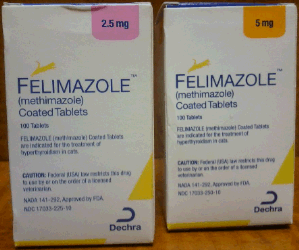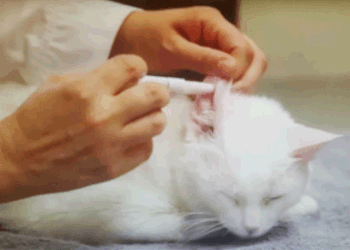|
THYROID TREATMENT: ORAL MEDICATION

MEDICATION FOR HYPERTHYROIDISM
|
The most common medication prescribed to treat feline hyperthyroidism is called METHIMAZOLE (TRADE NAME "TAPAZOLE" or "FELIMAZOLE"). This medication has virtually replaced the older medication PROPYLTHIOURACIL or “PTU” because methimazole is effective without as much tendency for side effects. In the United Kingdom and Australia, carbimazole is sometimes used. Because carbamizole is converted to methimazole in the body, the information presented here for methimazole also holds for carbamizole.
All these medications block the production of T4 and T3. Thyroid hormones already present in the body when medication is started are still "in play" thus a good 2-4 weeks are needed before thyroid blood tests will show the effect of treatment.
It is important to understand what the potential side effects of methimazole and its relatives are and the monitoring that is generally recommended. The thyroid "nodule" which can be detected in the cat's throat will not reduce in size with treatment and may in fact get larger.
|

(original graphic by marvistavet.com)
|
ADVANTAGES OF USING METHIMAZOLE:
- Medication is inexpensive relative to radiotherapy or surgery, at least in the short term. Methimazole is just as effective as radiotherapy or surgery as long as it is used properly.
- Control of thyroid disease is achieved only while the pet is on medication so that if there is any problem with exacerbation of poor kidney function, treatment can be discontinued. In other words, the effects of methimazole are reversible.
- No hospitalization is required.
- Side effects are relatively uncommon.
- If an occasional dose is skipped, no harm is done.
- If after the first 3 months of therapy no side effects have been encountered, the chance of side effects occurring thereafter is substantially reduced.
DISADVANTAGES OF USING METHIMAZOLE:
- Medication must be given at least daily (usually twice daily). Some cats simply will not take oral tablets reliably or cooperatively at this frequency and providing pills in the cat's food is notoriously inconsistent. That said, however, methimazole can readily made into a flavored liquid or chewable for easier administration by a compounding pharmacy or it may even be possible to convert methimazole into a gel administered on the hairless inner surface of the cat’s ear (see below).
- Approximately 15% of cats will experience some kind of side effect. The usual side effects are: lethargy, loss of appetite, and vomiting. If one of these side effects occurs, medication is discontinued until the symptoms resolve. Medication is then restarted at a lower dose and gradually increased to the former dose. These side effects do not generally recur if medication is increased gradually in this way.
- Facial itching is a more significant side effect because it means the cat in question cannot tolerate methimazole. The facial itching side effect resolves with anti-itch medication and discontinuation of methimazole but cats who have this side effect can be expected to have it again if medication is restarted so another form of treatment should be instituted for the thyroid disease. Facial itching occurs in less than 4% of cats on methimazole.
- Potentially serious liver disease results in a extremely small number (less than 2%) of cats taking methimazole. This toxicity can be expected to resolve after discontinuation of the medication but, again, alternative therapy for the thyroid disease will be needed if the cat cannot tolerate methimazole without developing liver disease.
- Bone marrow changes can also result from methimazole administration. Blood tests evaluating white blood cell patterns should be periodically performed to monitor for these changes. This side effect occurs in less than 4% of cats on methimazole but should it occur it necessitates a change in therapy.
- Pre-existing kidney insufficiency can be masked in hyperthyroidism. This is because the heart disease and high blood pressure that go with hyperthyroidism actually increase blood flow through the kidneys making the kidneys more efficient (virtually the only positive aspect of having hyperthyroidism). Once treatment is instituted for hyperthyroidism, the kidney disease is unmasked or made worse when kidney blood flow returns to normal. Sometimes it is necessary to find a happy medium between treating the kidneys and treating the thyroid, thus monitoring kidney function along with thyroid levels is particularly important during methimazole therapy.
- Kidney problems can be minimized by starting with a lower dose of methimazole and working up over weeks or months so as not to cause as abrupt a change in kidney blood flow. If kidney problems become significantly worse on methimazole, medication can be discontinued. Approximately 15-22% of cats treated for hyperthyroidism will show kidney disease that was not evident prior to treatment.
- A study published in the February 15th, 2006, Journal of the AVMA by Milner et al found that when one excludes cats with pre-existing renal disease from the group and compares cats treated with radiotherapy vs. those treated with methimazole, those treated with radiotherapy had a much longer median survival time (4 years vs. 2 years). This may be due to difficulties in regularly medicating cats with oral medication and ultimately leading to periods of incomplete treatment.
MOST SIDE EFFECTS OCCUR DURING THE FIRST 3 MONTHS OF METHIMAZOLE THERAPY. Periodic blood testing to examine T4 level, white blood cell patterns, kidney function, and liver enzymes should be performed. Be sure to ask your veterinarian to review an appropriate schedule for your cat. Side effect potential can be reduced by beginning the cat at a smaller dose and working up to the full therapeutic dose over the first couple of months of therapy.
Methimazole tablets should be stored at room temperature, protected from light.
|
TRANSDERMAL METHIMAZOLE
Many cats remain untreated for this ultimately debilitating disease because their owners cannot administer the medication. For many cats even converting the medication into liquid does not yield a comfortable alternative. Fortunately, another format for methimazole administration has emerged: transdermal gel that is applied to the hairless portion of the inner ear.
ADVANTAGES OF TRANSDERMAL THERAPY:
- No need to fight with the cat over oral medication.
- Decreased potential for intestinal side effects. (No decreased potential for the non-intestinal side effects reviewed above. For those side effects, it does not help to give the medication topically).
|

(Photocredit: Diamondback Drugs via YouTube)
|
DISADVANTAGES OF TRANSDERMAL THERAPY:
- It may take longer to achieve normal thyroid levels. (In one study, after 4 weeks of treatment, 82% of the cats on oral methimazole were controlled but only 67% of the cats on transdermal therapy were controlled).
- A compounding pharmacy must custom make the product.
Transdermal methimazole should be stored according to the compounding pharmacy's instructions.
IS THERE AN ALTERNATIVE TO METHIMAZOLE?
It seems there are always some cats who cannot take methimazole due to side effects and cannot undergo radiotherapy due to expense. For these cats, dietary therapy may work out (click here for more information). Other medications available are reviewed below:
An alternative medication called Ipodate (an iodine-based radiographic contrast agent) has been investigated. This medication inhibits the conversion` of T4 to T3 (as opposed to methimazole which inhibits production of T4). In a study of 12 hyperthyroid cats, 8 responded well to ipodate with no negative side effects. More severe cases of hyperthyroidism tend not to respond. This seems like an attractive alternative, except that nearly as soon as the research was published, the product went off the market, having been surpassed in radiology by more efficient contrast media. A similar compound called Iopanoic Acid appears to be similar in effect to Ipodate but is difficult to obtain. It is available through compounding pharmacies if at all.
Another approach for cats who cannot take methimazole involves a combination of potassium iodate and a heart medication called “propranolol.” Potassium iodate blocks the thyroid gland’s uptake of iodine. The propanolol is used to control the heart disease that is common in hyperthyroid cats with the dose depending on the patient’s heart rate. Side effects of potassium iodate consisted of upset stomach and depression in 13 out of 20 cats and were controlled by reducing the dose. While all cats seemed better in this study with medication, less than 50% achieved normal lab values; further, all the cats of this study took these medications in preparation for thyroid surgery so long term follow-up was not conducted. Still, for a cat that cannot tolerate more conventional treatment, this may be a reasonable alternative.
Specifics on protocols for either of the above therapies are outlined in The Options for Treating Hyperthyroidism by Dr. D. Bruyette in the November 2004 issue of Veterinary Medicine.

Short version (to help uscomply with "Lizzie's Law")
Page last updated: 9/4/2021
|